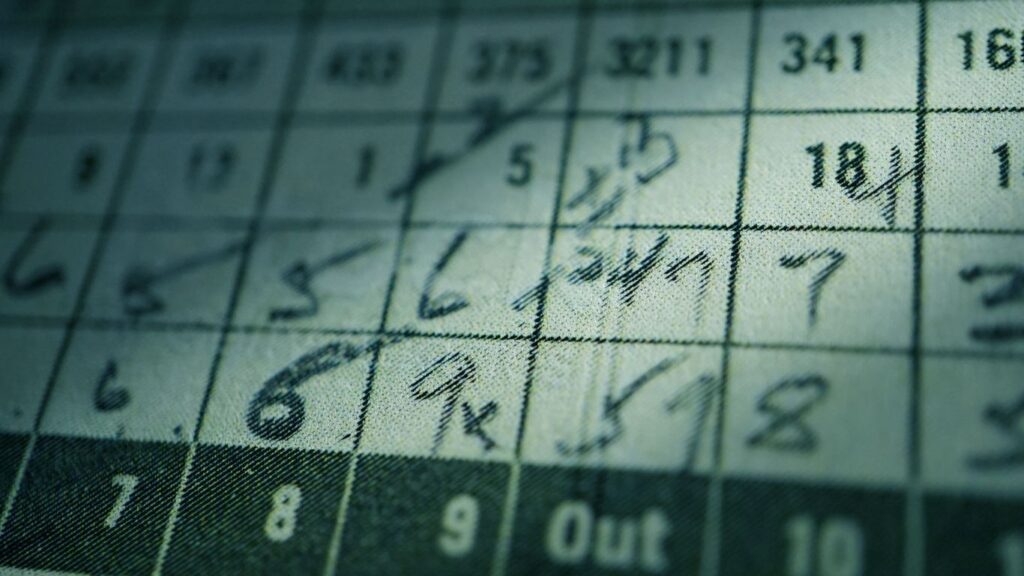Are you a golf enthusiast looking to improve your game? Or perhaps you’re just starting out as an amateur golfer and want to know what is considered an average, good or bad score on the course?
No matter where you are in terms of skill level, understanding the basics of scoring can help take your game to the next level. In this article, we will provide a guide for both 9-hole and 18-hole scores so that you can identify areas where improvement is needed and track your progress as you get better.
Keep reading to learn more about what is a good golf score!

Let’s start with the golf scoring basics.
The basic unit of scoring in golf is called a “stroke,” and is used to measure the number of times it takes for you hit the ball from the tee into the hole. One hole on the course is completed once all players have finished playing their strokes and made it into the hole.
The total number of strokes taken by a player over the course of the entire game is called their score. A good score means you were able to complete the hole or course using fewer strokes than your opponents or average players on that same hole or course.
9 Hole Course:
Good Golf Score: 36-38 Strokes (Par = 36)
Average Golf Score: 39-42 Strokes (Par = 36)
Bad Golf Score: 43+ Strokes (Par = 36)
18 Hole Course:
Good Golf Score: 70-72 Strokes (Par = 72)
Average Golf Score: 73-76 Strokes (Par = 72)
Bad Golf Score: 77+ Strokes (Par = 72)
These scores are based on the standard “Par” score for a course. Par is the average number of strokes that it should take an experienced player or professional golfers to complete a hole, and this will vary from course to course depending on various factors such as terrain, length of the hole and other elements.
So, you may find that your scores are better or worse than these numbers depending on how difficult the golf course is.
Golf Scoring Terminology
Hole In One
A Hole-in-One occurs when a player is able to complete the hole in one stroke.
Albatross
A Albatross is a really good score in golf. It means you were able to put the golf ball in the hole using three strokes less than the average number of strokes it should take an experienced player to complete the hole.
Eagle
An Eagle in golf is when a player finishes the hole using two strokes less than the average number of strokes it should take an experienced player to complete it.
Birdie
A Birdie is when a player finishes the hole using one stroke less than the average number of strokes it should take an experienced player to complete it.
Par
In golf, a par is the average number of strokes it should take an experienced player to complete a hole. It is different for each hole and different golf courses because it depends on factors like length and terrain.
Bogey
A double bogey is when a player takes two more strokes than the average number of strokes it should take an experienced player to finish a hole.
Double Bogey
A Double Bogey is when you take two more strokes than the average number of strokes it should take an experienced player to complete a hole in golf.
Triple Bogey
A Triple Bogey in golf is when a player takes three strokes more than the average number of strokes it should take an experienced player to complete the hole.
Quadruple Bogey
A Quadruple Bogey in golf is when a player takes four strokes more than the average number of strokes it should take an experienced player to complete the hole.
Quintuple Bogey
A Quintuple Bogey is when you take five extra strokes to complete the hole compared to the average number of strokes it should take an experienced player.
Sextuple Bogey
A Sextuple Bogey is a score in golf where it takes you six strokes more than the average to complete a hole.
Septuple Bogey
A Septuple Bogey is when a player finishes the hole using seven strokes more than the average number of strokes it should take an experienced player to complete it.
Octuple Bogey
A Octuple Bogey is when you take eight strokes more than the average number of strokes it should take an experienced player to complete a hole in golf.

A good golf score is based on the following numbers
For 9-hole scores, if you shoot a score in the 40s or lower, it’s considered good. Scores in the 50s are average and anything over that would be considered bad. On an 18-hole round of golf, shooting anywhere from the 70s to the low 80s is considered good.
Scores in the mid-80s are considered average and anything above that is bad. Of course, these numbers can vary depending on the difficulty of the course you’re playing on.
Average Golf Score By Age For 9 & 18 Holes
When it comes to average golf scores, age is a factor that can impact your results. On 9-hole courses, typically younger players tend to score in the low 50s while older players may shoot in the mid-50s.
For 18-hole courses, younger players are likely to score in the high 80s while more experienced golfers may shoot in the low to mid-80s.
Keep in mind that these numbers are just averages and your score can vary depending on many factors, such as your skill level and experience.
As you become more familiar with golf and practice more often, you should expect to see your scores improve over time.
How can I compare my average score to others?
If you want to compare your scores to other golfers, a great way to do this is to join a league or tournament. This will allow you to play against other players of varying skill levels and get an idea of how your game stacks up.
You can also use online tools such as GolfStat’s Score Analysis page to quickly find out how your scores compare to others.
Another way to compare your average score against other amateur golfers is using the handicap system, which compares your golf score against a “standard” score.
This system is based on the concept of par and will provide you with an accurate comparison of how your game measures up against other players.

What’s an average golf score for beginner golfers?
The average golf score for a beginner golfer is typically in the mid to high 90son an 18-hole course. As you become more experienced, you should expect to see your scores improve as your skills and knowledge of the game increase.
With practice and dedication, it is not uncommon for beginner golfers to be able to shoot in the low 80s after six to nine months of consistent practice.
What’s a good golf score for seniors?
For senior amateur golfers, a good golf score for 9-hole courses would be in the 40s or lower. On an 18-hole round of golf, shooting anywhere from the 70s to the low 80s is considered a good score.
Of course, these numbers can vary depending on the difficulty of the course you’re playing on and your overall skill level.
Additionally, seniors may find it beneficial to join a golf league or tournament in order to compare their scores with other golfers of similar skill levels. This can help you track your progress and set goals for improvement.

What is a good golf score for college?
A good golf score for college will vary depending on the skill level of the golfer and the course being played. Generally, a score of 80 or better is considered an excellent round for college golfers.
For most collegiate tournaments, scores around 75 or lower are considered to be very competitive.
Scores in the 70s are usually necessary to be competitive in collegiate tournaments and even lower scores are necessary to be a top finisher.
A score of 90 or higher is considered an average round, while a score of 100 or more is considered below average. Scores higher than 110 should generally be avoided and can significantly impact a golfer’s overall score for the season.
Ultimately, the goal is to consistently score in the 70s and strive to break par.
What is a good golf score for young golfers?
A good golf score for young golfers will depend on the golfer’s age, skill level, and course being played. Generally, a score of 100 or better is considered an excellent round for young golfers.
Most scores around 90 or lower are considered to be very competitive for junior tournaments and events. Scores in the 80s are usually necessary to be competitive in junior tournaments and even lower scores are necessary to be a top finisher.
A score of 110 or higher is considered an average round, while a score of 120 or more is considered below average.
Scores higher than 130 should generally be avoided and can significantly impact a golfer’s overall score for the season.
What is bogey golf in Golf?
Bogey golf is the score a golfer would expect to make on an average hole if they took two shots over par. For example, if the par for a hole is 4, then bogey golf would be 6 strokes.
Bogey golf is generally used as a baseline measure for players of all skill levels and is seen as an achievable goal for all amateur golfers. Bogey golf can also be used to compare scores between different courses and players of different skill levels, as it provides a consistent way to measure performance.
A golfer’s score is considered very good if they are able to consistently shoot bogey or better on each hole. Overall, bogey golf is a great measure of a golfer’s performance and can be used to set goals for improvement.
The key to improving your golf game is understanding what your current score is, setting realistic goals, and working hard to achieve them. By tracking your scores and comparing them against other players you can get an accurate assessment of where you stand in terms of skill level. This can help you identify areas for improvement and set realistic objectives to become a better golfer.







